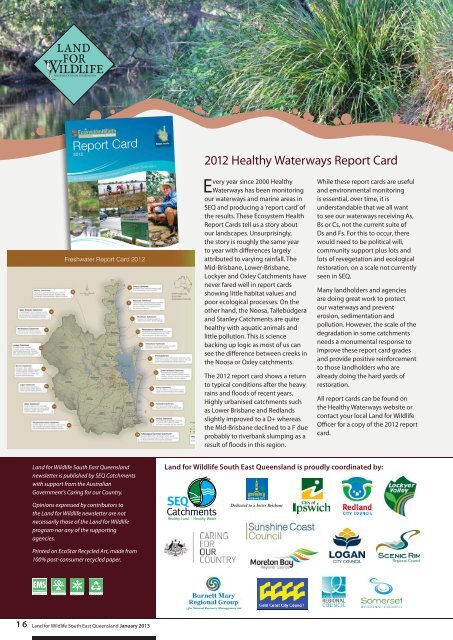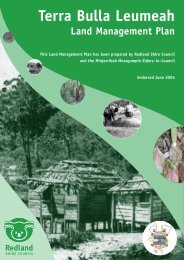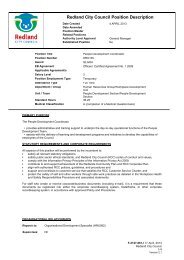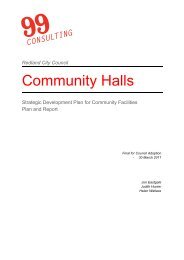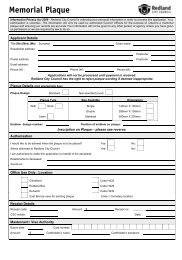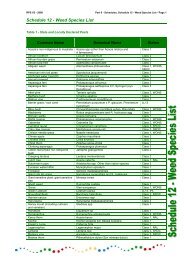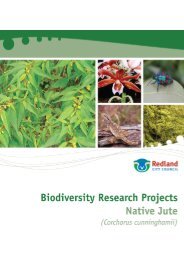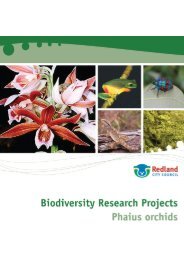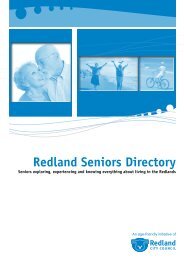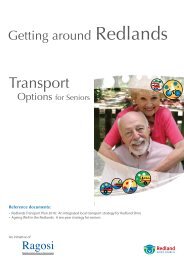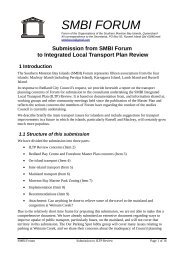Land for Wildlife Newsletter - IndigiScapes
Land for Wildlife Newsletter - IndigiScapes
Land for Wildlife Newsletter - IndigiScapes
You also want an ePaper? Increase the reach of your titles
YUMPU automatically turns print PDFs into web optimized ePapers that Google loves.
2012 Healthy Waterways Report Card<br />
Every year since 2000 Healthy<br />
Waterways has been monitoring<br />
our waterways and marine areas in<br />
SEQ and producing a ‘report card’ of<br />
the results. These Ecosystem Health<br />
Report Cards tell us a story about<br />
our landscapes. Unsurprisingly,<br />
the story is roughly the same year<br />
to year with differences largely<br />
attributed to varying rainfall. The<br />
Mid-Brisbane, Lower-Brisbane,<br />
Lockyer and Oxley Catchments have<br />
never fared well in report cards<br />
showing little habitat values and<br />
poor ecological processes. On the<br />
other hand, the Noosa, Tallebudgera<br />
and Stanley Catchments are quite<br />
healthy with aquatic animals and<br />
little pollution. This is science<br />
backing up logic as most of us can<br />
see the difference between creeks in<br />
the Noosa or Oxley catchments.<br />
The 2012 report card shows a return<br />
to typical conditions after the heavy<br />
rains and floods of recent years.<br />
Highly urbanised catchments such<br />
as Lower Brisbane and Redlands<br />
slightly improved to a D+ whereas<br />
the Mid-Brisbane declined to a F due<br />
probably to riverbank slumping as a<br />
result of floods in this region.<br />
While these report cards are useful<br />
and environmental monitoring<br />
is essential, over time, it is<br />
understandable that we all want<br />
to see our waterways receiving As,<br />
Bs or Cs, not the current suite of<br />
Ds and Fs. For this to occur, there<br />
would need to be political will,<br />
community support plus lots and<br />
lots of revegetation and ecological<br />
restoration, on a scale not currently<br />
seen in SEQ.<br />
Many landholders and agencies<br />
are doing great work to protect<br />
our waterways and prevent<br />
erosion, sedimentation and<br />
pollution. However, the scale of the<br />
degradation in some catchments<br />
needs a monumental response to<br />
improve these report card grades<br />
and provide positive rein<strong>for</strong>cement<br />
to those landholders who are<br />
already doing the hard yards of<br />
restoration.<br />
All report cards can be found on<br />
the Healthy Waterways website or<br />
contact your local <strong>Land</strong> <strong>for</strong> <strong>Wildlife</strong><br />
Officer <strong>for</strong> a copy of the 2012 report<br />
card.<br />
<strong>Land</strong> <strong>for</strong> <strong>Wildlife</strong> South East Queensland<br />
newsletter is published by SEQ Catchments<br />
with support from the Australian<br />
Government’s Caring <strong>for</strong> our Country.<br />
<strong>Land</strong> <strong>for</strong> <strong>Wildlife</strong> South East Queensland is proudly coordinated by:<br />
Opinions expressed by contributors to<br />
the <strong>Land</strong> <strong>for</strong> <strong>Wildlife</strong> newsletter are not<br />
necessarily those of the <strong>Land</strong> <strong>for</strong> <strong>Wildlife</strong><br />
program nor any of the supporting<br />
agencies.<br />
Printed on EcoStar Recycled Art, made from<br />
100% post-consumer recycled paper.<br />
16<br />
<strong>Land</strong> <strong>for</strong> <strong>Wildlife</strong> South East Queensland January 2013


